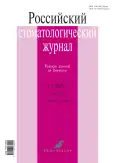Use of minimally invasive technologies in oral care in children
- Authors: Abdullaeva A.I.1, Pustovaya E.P.2, Slonova V.M.2, Karnaeva A.S.2, Pilshchikova O.V.2, Kozhevnikova L.A.2, Gasanova Z.M.2
-
Affiliations:
- Pirogov Russian National Research Medical University
- RUDN university
- Issue: Vol 25, No 1 (2021)
- Pages: 85-90
- Section: Reviews
- URL: https://journals.rcsi.science/1728-2802/article/view/89258
- DOI: https://doi.org/10.17816/1728-2802-2021-25-1-85-90
- ID: 89258
Cite item
Abstract
This article presents a review of studies that have focused on the technology of minimally invasive caries removal, endodontic treatment, and dental restoration. Databases of Scopus, Web of Science, and MedLine were searched for relevant studies. With ongoing comprehensive investigation of various diseases, present-day medicine has changed from using a biomedical model to a biopsychosocial medical model, so increasing attention is being paid to the concept of minimally invasive treatment in dentistry. The concept of minimally invasive technology has given rise to a number of minimally invasive methods for the diagnosis and treatment of oral diseases. Taking into account the psychology, health status, function, and aesthetics of the patient, minimal intervention is required. Children, as a special group of patients, are in the period of the initial formation of their psychological structure. In this regard, the goal of dental treatment of children should not be limited to restoring functions and relieving pain; it is also worth paying attention to their development and physical and mental health. Therefore, in recent years, minimally invasive technology has gradually been used in the diagnosis and treatment of oral diseases in children.
Full Text
##article.viewOnOriginalSite##About the authors
Aitan I. Abdullaeva
Pirogov Russian National Research Medical University
Email: aitanka@list.ru
ORCID iD: 0000-0001-9206-7306
Russian Federation, Moscow
Elena P. Pustovaya
RUDN university
Author for correspondence.
Email: valeri99@bk.ru
ORCID iD: 0000-0001-5390-4183
MD, Cand. Sci. (Med.), assistant professor
Russian Federation, 6, Miklukho-Maklay str, 117198, MoscowVeranika M. Slonova
RUDN university
Email: slonova.1966@mail.ru
ORCID iD: 0000-0002-5794-6580
MD, Cand. Sci. (Med.)
Russian Federation, 6, Miklukho-Maklay str, 117198, MoscowAmina S. Karnaeva
RUDN university
Email: amina1970@bk.ru
ORCID iD: 0000-0002-7814-1730
MD, Cand. Sci. (Med.)
Russian Federation, 6, Miklukho-Maklay str, 117198, MoscowOlga V. Pilshchikova
RUDN university
Email: pildent@mail.ru
MD, Cand. Sci. (Med.)
Russian Federation, 6, Miklukho-Maklay str, 117198, MoscowLudmila A. Kozhevnikova
RUDN university
Email: luda-dent@mail.ru
MD, Cand. Sci. (Med.)
Russian Federation, 6, Miklukho-Maklay str, 117198, MoscowZarema M. Gasanova
RUDN university
Email: g.m.zarema@mail.ru
ORCID iD: 0000-0002-9655-6702
Russian Federation, 6, Miklukho-Maklay str, 117198, Moscow
References
- Walsh LJ, Brostek AM. Minimum intervention dentistry principles and objectives. Aust Dent J. 2013;58, Suppl 1:3–16. doi: 10.1111/adj.12045
- Persin LS, Elizarova VM, D’yakova SV. Stomatologiya detskogo vozrasta. Moscow: Meditsina; 2006. (In Russ).
- Shakovets NV, Terekhova TN. Features of oral hygiene in infants. Dental Forum. 2014;(4):101–102. (In Russ).
- Mount GJ. Minimal intervention dentistry: rationale of cavity design. Oper Dent. 2003;28(1):92–99.
- Sathyanarayanan R, Carounnanidy U. Classification and management of dental caries. New concepts. Indian J Dent Res. 2002;13(1):21–25.
- Bazikyan EA. Propaedeutic dentistry. Moscow: GEOTAR-Media; 2010. (In Russ).
- Jepsen S, Acil Y, Peschel T, et al. Biochemical and morphological analysis of dentin following selective caries removal with a fluorescence-controlled Er:YAG laser. Lasers Surg Med. 2008;40(5):350–357. doi: 10.1002/lsm.20631
- Shakovets N, Klenovskaya M. Abstract: caries risk assessment (literature review). Stomatologiceskij zurnal. 2015;(4):256–263. (In Russ).
- Lutzkaya IK, Tserakhava TM. Individual oral hygiene in children. Dentistry today. 2014;(2):13–20. (In Russ).
- Maltz M, Alves LS. Incomplete caries removal significantly reduces the risk of pulp exposure and post-operative pulpal symptoms. J Evid Based Dent Pract. 2013;13(3):120–122. doi: 10.1016/j.jebdp.2013.07.014
- Kisel’nikova LP. Detskaya stomatologiya. Moscow: GEOTAR-Media; 2014. (In Russ).
- Olivi G, Genovese MD. Laser restorative dentistry in children and adolescents. Eur Arch Paediatr Dent. 2011;12(2):68–78. doi: 10.1007/BF03262782
- Yazdanfar I, Gutknecht N, Franzen R. Effects of diode laser on direct pulp capping treatment: a pilot study. Lasers Med Sci. 2015;30(4):1237–1243. doi: 10.1007/s10103-014-1574-8
- Motokawa W, Braham RL, Teshima B. Clinical evaluation of light-cured composite resin inlays in primary molars. Am J Dent. 1990;3(3):115–118.
- Kuryakina NV. Terapevticheskaya stomatologiya detskogo vozrasta. Moscow: Meditsina; 2004. (In Russ).
- Rezende KM, Moraes Pde C, Oliveira LB, et al. Cryosurgery as an effective alternative for treatment of oral lesions in children. Braz Dent J. 2014;25(4):352–356. doi: 10.1590/0103-6440201302254
Supplementary files






